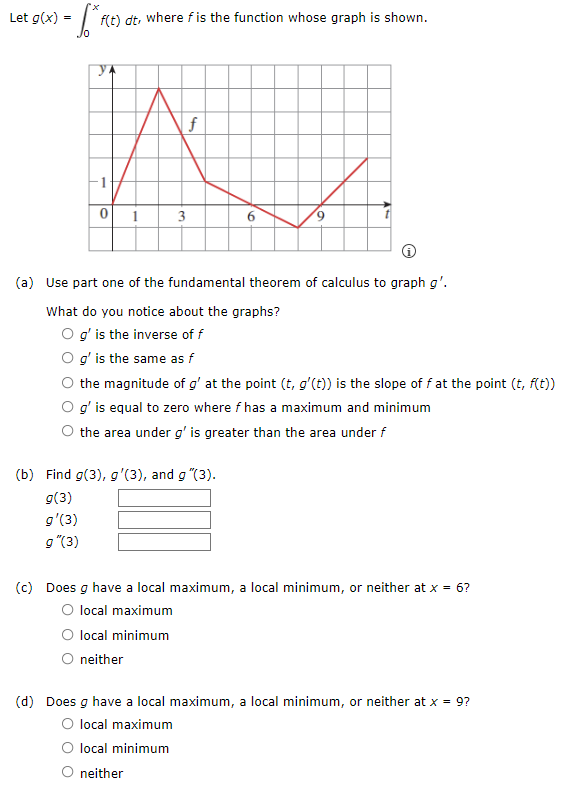Let g(x) = - for f(t) dt, where f is the function whose graph is shown. y f 0 1 3 6 (a) Use part one of the fundamental theorem of calculus to graph g'. What do you notice about the graphs? Og' is the inverse of f O g' is the same as f the magnitude of g' at the point (t, g'(t)) is the slope of f at the point (t, f(t)) O g' is equal to zero where f has a maximum and minimum the area under g' is greater than the area under f (b) Find g(3), g'(3), and g "(3). g(3) g'(3) 9"(3) (c) Does g have a local maximum, a local minimum, or neither at x = 6? O local maximum O local minimum O neither (d) Does g have a local maximum, a local minimum, or neither at x = 9? O local maximum local minimum O neither
Let g(x) = - for f(t) dt, where f is the function whose graph is shown. y f 0 1 3 6 (a) Use part one of the fundamental theorem of calculus to graph g'. What do you notice about the graphs? Og' is the inverse of f O g' is the same as f the magnitude of g' at the point (t, g'(t)) is the slope of f at the point (t, f(t)) O g' is equal to zero where f has a maximum and minimum the area under g' is greater than the area under f (b) Find g(3), g'(3), and g "(3). g(3) g'(3) 9"(3) (c) Does g have a local maximum, a local minimum, or neither at x = 6? O local maximum O local minimum O neither (d) Does g have a local maximum, a local minimum, or neither at x = 9? O local maximum local minimum O neither
Calculus: Early Transcendentals
8th Edition
ISBN:9781285741550
Author:James Stewart
Publisher:James Stewart
Chapter1: Functions And Models
Section: Chapter Questions
Problem 1RCC: (a) What is a function? What are its domain and range? (b) What is the graph of a function? (c) How...
Question

Transcribed Image Text:Let g(x)
=
- for f(t) dt, where f is the function whose graph is shown.
y
f
0
1
3
6
(a) Use part one of the fundamental theorem of calculus to graph g'.
What do you notice about the graphs?
Og' is the inverse of f
O g' is the same as f
the magnitude of g' at the point (t, g'(t)) is the slope of f at the point (t, f(t))
O g' is equal to zero where f has a maximum and minimum
the area under g' is greater than the area under f
(b) Find g(3), g'(3), and g "(3).
g(3)
g'(3)
9"(3)
(c) Does g have a local maximum, a local minimum, or neither at x = 6?
O local maximum
O local minimum
O neither
(d) Does g have a local maximum, a local minimum, or neither at x = 9?
O local maximum
local minimum
O neither
Expert Solution
This question has been solved!
Explore an expertly crafted, step-by-step solution for a thorough understanding of key concepts.
This is a popular solution!
Trending now
This is a popular solution!
Step by step
Solved in 2 steps with 7 images

Recommended textbooks for you

Calculus: Early Transcendentals
Calculus
ISBN:
9781285741550
Author:
James Stewart
Publisher:
Cengage Learning

Thomas' Calculus (14th Edition)
Calculus
ISBN:
9780134438986
Author:
Joel R. Hass, Christopher E. Heil, Maurice D. Weir
Publisher:
PEARSON

Calculus: Early Transcendentals (3rd Edition)
Calculus
ISBN:
9780134763644
Author:
William L. Briggs, Lyle Cochran, Bernard Gillett, Eric Schulz
Publisher:
PEARSON

Calculus: Early Transcendentals
Calculus
ISBN:
9781285741550
Author:
James Stewart
Publisher:
Cengage Learning

Thomas' Calculus (14th Edition)
Calculus
ISBN:
9780134438986
Author:
Joel R. Hass, Christopher E. Heil, Maurice D. Weir
Publisher:
PEARSON

Calculus: Early Transcendentals (3rd Edition)
Calculus
ISBN:
9780134763644
Author:
William L. Briggs, Lyle Cochran, Bernard Gillett, Eric Schulz
Publisher:
PEARSON

Calculus: Early Transcendentals
Calculus
ISBN:
9781319050740
Author:
Jon Rogawski, Colin Adams, Robert Franzosa
Publisher:
W. H. Freeman


Calculus: Early Transcendental Functions
Calculus
ISBN:
9781337552516
Author:
Ron Larson, Bruce H. Edwards
Publisher:
Cengage Learning